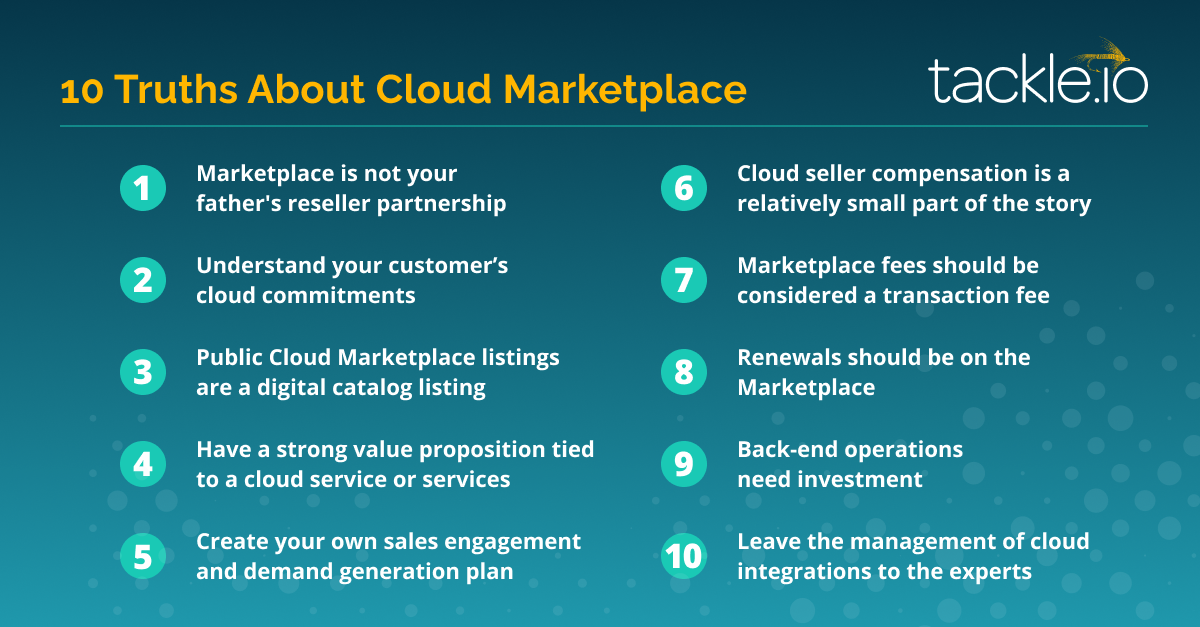From public listings to compensation, Tackle advisor Todd Osborne shares 10 key things to know about AWS, Google Cloud, and Microsoft Marketplaces
Whether it’s “Listing and selling on Marketplace is too complex” or “Cloud Providers aren’t interested in co-selling with my business,” myths and misconceptions often drive the conversations around Cloud Marketplace.
Todd Osborne, Tackle advisor and former alliances and channel lead for New Relic, shares his top 10 truths about listing, selling, and scaling with the Cloud Marketplaces.
Truth #1: Marketplace is not your father’s reseller partnership
Alliances and partner leaders need to reset expectations around Marketplace for business units who aren’t regularly interacting in this world. In a traditional reseller dynamic, the relationships a seller had with buyers and technologists were key to scaling sales and achieving more leverage and reach. It remains a largely margin-based system in terms of transactions.
Cloud Marketplace is less about the traditional “buy and sell” relationship and more about choosing to join the ecosystem of AWS, Azure, GCP, and/or Red Hat. Sellers gain influence and leverage through the Cloud Partner and the surrounding ecosystem. As customers expand their cloud spend, your company benefits as a part of the cloud ecosystem.
Truth #2: Understand your customer’s cloud commitments
Sellers must understand a customer’s cloud commitment and overall digital transformation strategy in order to sell. Everything from how much money the company is committing, why they’ve selected that Cloud Provider, who signed off on the deal, and who is responsible for deploying the cloud is all valuable intel. Sales teams that understand dynamics and the customer’s cloud strategy will offer more value.
Read More: Ask the Experts: Getting Your C-Suite on Board for Marketplace
Truth #3: Public Cloud Marketplace listings are a digital catalog listing
Most vendors selling enterprise software don’t get a lot of business out of the public listings.
Most vendors selling enterprise software don’t get a lot of business out of the public listings. Though some vendors enable product-led entry points and transactions at list prices, and public Cloud Marketplace can be a good way to get started, when it comes to enterprise software most customers will want to negotiate pricing and terms. Private offers allow the vendors to provide additional discounts and custom terms for transactions, and offer an opportunity for the customer to speak with the vendor.
Think about your public listing as an advertisement or a digital catalog. It’s a good place for prospects to learn more information, but unless you sell at list prices, don’t plan on many sales from it.
Read more: The Advantages of Private Offers and Private Plans
Truth #4: Have a strong value proposition tied to a cloud service or services
The more an ISV can attach its value proposition to a cloud service or ecosystem, the better the relationship with the Cloud Provider. If you’re able to demonstrate to the Cloud Provider’s sales and technical teams how your offering helps enterprises utilize and consume more cloud services, it creates an opportunity to co-sell and jointly engage in account strategy and customer meetings.
Truth #5: Create your own sales engagement and demand generation plan
Simply existing on Marketplace won’t drive leads or new business.
Simply existing on Marketplace won’t drive leads or new business. Driving quality leads requires a coordinated effort across marketing, sales, inbound and outbound teams, and other go-to-market strategies. Cloud Providers may play a role in driving some leads and you may see some “drive-by” purchases, but ultimately those will be limited.
Create and market a quality listing and educate other parts of the business. Each team must understand both the high-level goals of the organization and how each piece of the business plays a role in the strategy.
Read More: How to Drive Organic Traffic to Your Marketplace Listing
Truth #6: Cloud seller compensation is a relatively small part of the story
In a traditional partnership, compensation was from a margin of the transaction, so sellers were motivated to drive those transactions. In Marketplace transactions, the sellers are compensated to drive Marketplace sales, but the focus is more on driving consumption. In Marketplace, the true interest between the sales teams comes from creating a value proposition that is going to drive consumption for the Cloud Provider.
Truth #7: Marketplace fees should be considered a transaction fee
Marketplace fees are relatively small compared to traditional partnerships. Do not think of a Marketplace fee in terms of resell uplift or margin. Instead, think of the fee more like a transaction you’d make as a consumer in a store, where the store would give a small percentage of the charge to the credit card company. Don’t let concerns about these fees limit your perception of its value. Your growth and net expansion will far surpass the fee, as long as there is a strong value proposition with the cloud provider.
Truth #8: Renewals should be on the Marketplace
While it can be tempting to think about conducting an initial transaction on Marketplace and then moving to direct for renewal transactions, conducting renewals on the Marketplace can actually be more valuable. Provided you have a good value proposition and relationship with the Cloud Provider, you might find higher net retention rates and increased size of renewals on Marketplace. Moving off platform would reduce the amount of continuous engagement with the Cloud Provider and create a disconnect from the customer’s cloud strategy.
Truth #9: Back-end operations need investment
Don’t forget about the finance systems, CRM systems, customer support systems and post-sale support, and other parts of the back-end operations. All of those pieces need to be adjusted to work with Marketplace. Consider how those operations will need to scale to accommodate end-of-quarter last-minute rushes or the manual interactions that may be needed for bookings. Marketplace has specific nuances that can be time-consuming, especially before systems are automated, so ensure you’re making the right investments in people, process, and technology to support the changes.
Read More: Build or Buy: A Practical Breakdown for Entering the Cloud Marketplace
Truth #10: Leave the management of cloud integrations to the experts
The integrations and setup for Marketplace are challenging and the process can be difficult for organizations to handle on their own. Even companies who are capable of building their own integrations soon discover that they’re putting a lot of time into something that’s not core to the business. Todd advised companies to “leave it to the experts” at Tackle. In addition to helping with the technical aspects, Tackle offers consulting and advice, and acts as a partner to companies as they navigate Marketplace.

Get even more insight into trends, predictions, and expert insight in Tackle’s State of the Cloud Marketplace Report.


